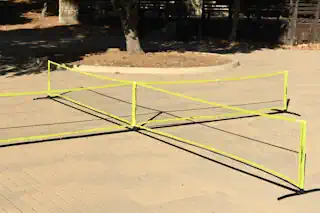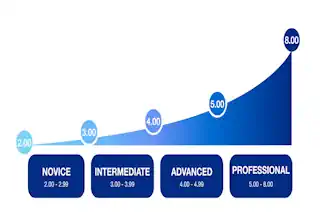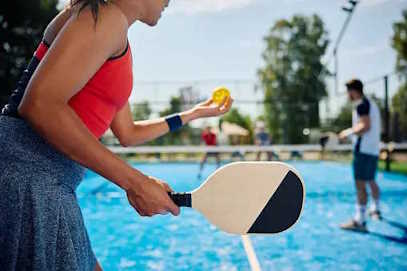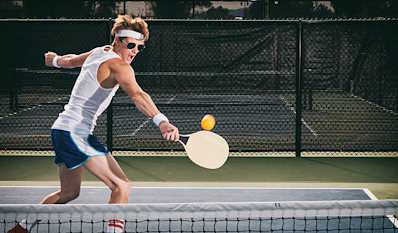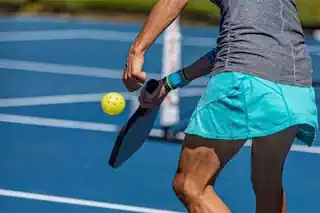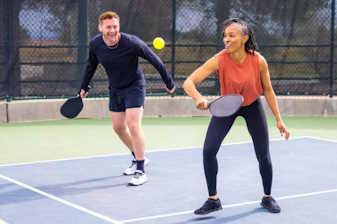Level Up Your Pickleball Game with the Hop Scotch Drill
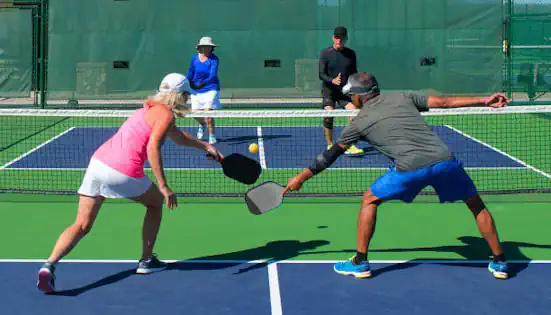
Pickleball, the beloved pastime that’s become a courtside favorite, is not just about those winning serves and ferocious volleys. It’s as much an art of agility and precision as it is a social sport. And for Pickleball aficionados who find joy in the strategic dance across the court, there’s a delightful drill that can amplify your pickleball shots and prowess — the hop scotch drill.
Whether you’re a seasoned player or just about to step onto the court for the first time, here’s how to solidify your stance and stride with this agile exercise.
Let’s Start with the Basic Rules of Pickleball
The Rules Reminder
Before we get into the swing of things, it’s important to know the fundamental rules of pickleball play. Players use solid paddles made of wood or composite materials to hit a perforated polymer ball, similar to a Wiffle Ball, over a net. The net is lower than in tennis but not as low as in badminton. The game can be played either with two players (singles) or four players (doubles).
Here’s a quick rundown of the basic pickleball rules to get you started. Think of it as your quick-start guide to fun:
Serve it right: Serve must be underhand with the paddle below the waist, and the ball must be hit in the air without bouncing. The serve is made diagonally across the court to the opponent’s service zone.
Service errors: Errors during service, such as serving out of turn, serving the ball into the net, or serving the ball out of bounds, lead to faults. Keeping a keen eye on your serve’s direction and height can help avoid these mistakes.
Double-bounce rule: After the ball is served, the receiving team must let it bounce once before returning, and then the serving team must also let the returned ball bounce once before playing it. After these two bounces, players may either volley the ball in the air or play it off a bounce.
No-volley zone: The court has a 7-foot zone on either side of the net, known as the “kitchen,” where players cannot volley the ball. Players must observe this rule to avoid faults.
Scoring: Points can only be scored by the serving team when the opponent fails to return the ball or commits a fault. The game is played to 11 points, and a team must win by at least 2 points.
Switching sides: Each team switches sides after the first game. In a tiebreaker (the third game of a match), teams switch sides when one team reaches 6 points.
Stepping into the kitchen on a volley: One of the most common faults in pickleball occurs when a player steps into the no-volley zone, or the kitchen, to hit a volley shot. Remember, you can step into the kitchen to hit the ball if it bounces first, but volleying from within this zone is a definite no-go.
Hitting the ball out of bounds: Just like in tennis or badminton, if the ball lands outside the designated play area, it’s considered out, and the point goes to the other team. Judging the ball’s trajectory and controlling your shot power are key skills to keep the ball in play.
Remember, pickleball is as much about having fun and making friends as it is about following these rules. Grab your paddle, and let’s hit the court with smiles and sportsmanship!
Equipment Essentials
The gear for Hop Scotch Pickleball isn’t much different from the standard variant. You’ll still need a net, a court, paddles, and pickleballs. The only ‘extra’ here is perhaps a tad bit more stamina and coordination.
The Purpose of Hop Scotch
The primary purpose of Hop Scotch is two fold. First it is to help each player with court awareness. For most players, letting a ball land out of bounds or stepping into the kitchen takes time to learn.
The second purpose is to help team players during doubles play learn to communicate without a need for speaking intention. If one player advances or retreats, unless previously planned, the team mate should stay back.
Here is how to Play Hopscotch
We start with a standard serve. Ball hit below the waist and cross court.
Next is the double bounce rule. The receiving team must let the ball bounce before hitting it back and the serving team must let the ball bounce before hitting it back
Now we start Hop Scotch
The serving team, immediately after hitting the return from the receiving team, must send one player into the kitchen. Yes, into the kitchen. The receiving team must also send one player into the kitchen while the other player stays back.
Each time the ball is returned, the players for the team who returned the ball must switch places. One in the kitchen and one behind the kitchen line or all the way in the back.
As play continues the players for both teams must move into and out of the kitchen. This could be as easy as a short hop or a full sprint forward and back.
The player in the kitchen must stay in the kitchen until the ball is returned. They must watch a drop shot fall into the back court and wait for their team mate to return the volley.
During singles play, a lob shot over the player trapped in the kitchen is a winning point.
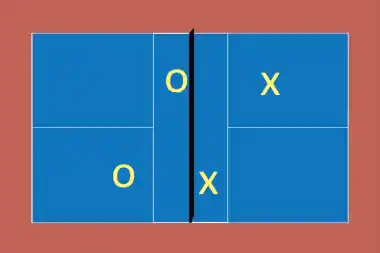
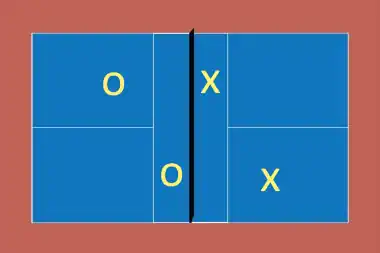
Understanding the Pickleball Hop Scotch Drill
Picture the traditional hop scotch game – the one with the numbered squares. Now, imagine the pickleball court as four squares. As a team or during single play you must be hoping into and out of the kitchen. If you are in the kitchen and the ball goes over your head you must stay in the kitchen. You’re practicing a drill that not only electrifies your footwork but fine-tunes your decision-making.
The Basics of the Drill
The hop scotch drill for pickleball is essentially a twist on speed and agility training. What sets it apart is the specific focus on the movements and pivots crucial to pickleball gameplay. Lateral shuffles, swift sprints, and controlled stops — you can tailor this drill to suit your skill level, ramping up the intensity with each round. It is also intended to get you thinking more about where you are on the court than on simply how and where you are going to hit the ball. In strategic terms, these simple drills are to get you thinking about the next shot both in terms of hits and space.
Dinking and Dropping
Mastering the ‘dink’ and the ‘drop’ can be game-changers in Hop Scotch. These soft, low shots are difficult to successfully execute when standing in the kitchen. Hence, one of the goals is to help you learn to effectively execute these soft shots while being right next to the net. The more strategic goal is to help you learn to recognize those times when being in the kitchen gives you greater ability to direct and win the shot.
Backhand shots and forehand shots standing in the kitchen give you great access to send the ball to the other side where it is un-returnable. However, when a player stands in the kitchen, being so close to the net can make these shots very difficult when they are below the net. The dinking game is very challenging when standing so close to the net. A drop shot can be very hard to execute when only one foot from the net.
The Lob Shot
In Hop Scotch, you will need to execute a lob shot when you opponent is trapped in the kitchen. It is the best way to place the ball where your opponent cannot return the shot. If your lob shot is short, the other team may be able to spike the ball and the round is over. If you are successful, the lob shot will be out of reach of the trapped player and land where the other player cannot get to it in time.
Learning to hit a successful lob shot from body position inside the kitchen is part of this drill. The strategic goal is to learn to recognize when you opponent is advancing or trapped and surprise them with a lob shot well placed in a back corner.
Benefits of Incorporating Hop Scotch into Your Routine
The hop scotch drill might feel like a fun diversion from the serious world of standard volley practice, but its benefits are as significant as they are accessible. In a round hopscotch the requirement to be in the kitchen will direct you to think more about body position, athletic stance, and your dominant side. Both players being on the same side will be more apparent and will limit how much power you can use on the volley.
Agility on Demand
Pickleball is not a gear-shifted game. It’s all about those seamless switches from one type of movement to another, often within seconds. The hop scotch drill readies you for these transitions, making your in-game agility seem almost second-nature. It also helps you think about where you are on the court and keeps you moving in response to the next play on the ball. Moving your feet to jump over the kitchen line is challenging. Just the left foot or the right foot is not enough. Both feet in or both feet out.
Refinement of Footwork
Footwork in pickleball isn’t a secondary action—it’s the choreography that your entire game is built on. This drill acts as a tutor, prompting better balance, quicker steps, and judicious positioning. This is especially true as you must execute from a very confined space and then retreat to cover the entire back court
Form and Technique
Don’t disregard the nuances of your form—regularly check in on your stance, your grip, and your shot execution. Ensuring you’re doing it right over and over builds that muscle memory, turning your actions from intentional to instinctive.
A Timely Introduction
Incorporating the hop scotch drill into your regular routine might mean reworking your practice schedule. But the dividends it returns in terms of improved speed, strategic prowess, and fitness are worth the rearrangements.
The Final Whack
The hop scotch drill—simple yet remarkably strategic. It’s a window into the essentials of pickleball before you’re even hit your first ball. Try it out, commit to the drill, and start savoring the change in your game.
In wrapping up, the hop scotch drill stands as a testament to the beauty and complexity of pickleball, weaving together agility, strategy, and precision in a dance that elevates your game. Whether you’re a seasoned player or just dipping your paddle into the waters of this intriguing sport, this drill offers a unique approach to mastering the court. By integrating it into your practice, you’re not just honing skills; you’re fostering a deeper connection with the rhythm of the game. Remember, each step, each shuffle, and each strategic play brings you closer to embodying the essence of pickleball. Here’s to stepping into the kitchen, and out, with confidence and joy. Keep playing, keep learning, and may your love for the game continue to grow.
Frequently Asked Questions (FAQ)
What is the “kitchen” in pickleball?
The “kitchen” refers to the non-volley zone on a pickleball court. It’s the area extending 7 feet from the net on both sides. Players are not allowed to volley the ball from within this zone.
How does the hop scotch drill improve my pickleball game?
The hop scotch drill is designed to enhance your agility, footwork, and strategic thinking on the court. By practicing rapid transitions and shot positioning, hopscotch players can refine their movements and improve their overall gameplay.
Can beginners try the hop scotch drill?
Absolutely! The hop scotch drill can be tailored to suit any skill level. Beginners might start with simpler movements and gradually increase the drill’s complexity as they become more comfortable with the game’s mechanics.
How often should I incorporate the hop scotch drill into my practice?
Incorporating the hop scotch drill into your practice sessions 1-2 times a week can significantly impact your agility and court awareness. However, the frequency can vary based on your overall practice schedule and goals.
Do I need any special equipment for this drill?
No special equipment is needed for the hop scotch drill other than a standard pickleball and net. The drill leverages the court’s dimensions and the player’s movements to create a dynamic and effective training experience.
Remember, the key to mastering pickleball, or any sport, is consistent practice, patience, and of course a positive attitude. Happy playing!
